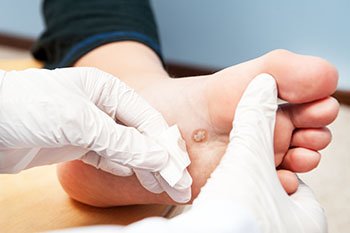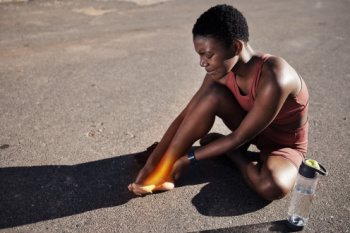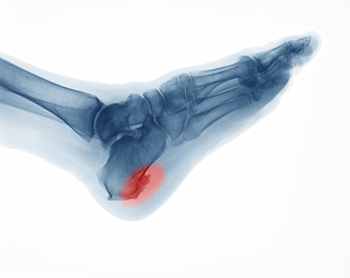April 2025
Arthritis Can Cause Pain in the Feet and Ankles
Managing Skin Warts on the Feet

Nongenital cutaneous warts, often found on the feet and toes, are caused by strains of the human papillomavirus, or HPV. These warts may appear as rough, thickened areas and sometimes grow inward due to pressure from walking. Treatment depends on the location, size, and persistence of the wart. Topical salicylic acid can help in mild cases by gradually peeling away layers of the wart. Cryotherapy, which uses liquid nitrogen to freeze the wart, is a common in-office procedure. Other methods include laser therapy, chemical treatments, or immune-based therapies to stimulate the body’s natural defense. In some cases, a minor surgical procedure may be required to remove deeply rooted or stubborn warts. Avoiding barefoot walking in public areas can help prevent future infections. If you have a persistent wart on your foot that is painful or not responding to treatment, it is suggested you see a podiatrist for a diagnosis and appropriate treatment.
Plantar warts can be very uncomfortable. If you need your feet checked, contact Dr. Thomas Madden from Advanced Foot Care Center. Our doctor will assist you with all of your foot and ankle needs.
About Plantar Warts
Plantar warts are the result of HPV, or human papillomavirus, getting into open wounds on the feet. They are mostly found on the heels or balls of the feet.
While plantar warts are generally harmless, those experiencing excessive pain or those suffering from diabetes or a compromised immune system require immediate medical care. Plantar warts are easily diagnosed, usually through scraping off a bit of rough skin or by getting a biopsy.
Symptoms
- Lesions on the bottom of your feet, usually rough and grainy
- Hard or thick callused spots
- Wart seeds, which are small clotted blood vessels that look like little black spots
- Pain, discomfort, or tenderness of your feet when walking or standing
Treatment
- Freezing
- Electric tool removal
- Laser Treatment
- Topical Creams (prescription only)
- Over-the-counter medications
To help prevent developing plantar warts, avoid walking barefoot over abrasive surfaces that can cause cuts or wounds for HPV to get into. Avoiding direct contact with other warts, as well as not picking or rubbing existing warts, can help prevent the further spread of plantar warts. However, if you think you have developed plantar warts, speak to your podiatrist. He or she can diagnose the warts on your feet and recommend the appropriate treatment options.
If you have any questions please feel free to contact our office located in Killeen, TX . We offer the newest diagnostic and treatment technologies for all your foot and ankle needs.
What Are the Most Common Foot Problems?

Feet work hard every day, so it is no surprise that they are prone to a variety of issues. Some of the most common foot problems include bunions, which cause a painful bump at the base of the big toe, and plantar fasciitis, a leading cause of heel pain. Flat feet, high arches, and hammertoes can also lead to discomfort and imbalance. Corns, calluses, and ingrown toenails are often caused by pressure or wearing poor-fitting shoes. Fungal infections like athlete’s foot or toenail fungus are also common, especially in damp environments. Overuse, aging, and medical conditions such as diabetes or arthritis can contribute to or worsen these issues. While some problems may improve with simple changes in footwear or home care, persistent pain or changes in the appearance of the feet should not be ignored, and it is suggested that you see a podiatrist.
Foot Pain
Foot pain can be extremely painful and debilitating. If you have a foot pain, consult with Dr. Thomas Madden from Advanced Foot Care Center. Our doctor will assess your condition and provide you with quality foot and ankle treatment.
Causes
Foot pain is a very broad condition that could be caused by one or more ailments. The most common include:
- Bunions
- Hammertoes
- Plantar Fasciitis
- Bone Spurs
- Corns
- Tarsal Tunnel Syndrome
- Ingrown Toenails
- Arthritis (such as Gout, Rheumatoid, and Osteoarthritis)
- Flat Feet
- Injury (from stress fractures, broken toe, foot, ankle, Achilles tendon ruptures, and sprains)
- And more
Diagnosis
To figure out the cause of foot pain, podiatrists utilize several different methods. This can range from simple visual inspections and sensation tests to X-rays and MRI scans. Prior medical history, family medical history, and any recent physical traumatic events will all be taken into consideration for a proper diagnosis.
Treatment
Treatment depends upon the cause of the foot pain. Whether it is resting, staying off the foot, or having surgery; podiatrists have a number of treatment options available for foot pain.
If you have any questions, please feel free to contact our office located in Killeen, TX . We offer the newest diagnostic and treatment technologies for all your foot care needs.
When Heel Pain Has a Hidden Cause

A calcaneal spur, often called a heel spur, is a bony growth that can quietly develop on the underside of the heel bone. While it may go unnoticed at first, it can lead to persistent or stabbing pain, especially with the first steps in the morning or after sitting for long periods. This condition is frequently associated with strain on the plantar fascia and is more common in individuals who spend long hours standing, have abnormal foot mechanics, or wear unsupportive shoes. The pain may worsen over time, eventually interfering with your ability to walk comfortably or maintain regular activity. In some cases, the discomfort leads to changes in posture or gait that cause further strain on other joints. Early attention can help prevent progression and reduce long-term impact. If you are experiencing ongoing heel pain, it is suggested that you see a podiatrist for a proper diagnosis and appropriate treatment.
Heel spurs can be incredibly painful and sometimes may make you unable to participate in physical activities. To get medical care for your heel spurs, contact Dr. Thomas Madden from Advanced Foot Care Center. Our doctor will do everything possible to treat your condition.
Heels Spurs
Heel spurs are formed by calcium deposits on the back of the foot where the heel is. This can also be caused by small fragments of bone breaking off one section of the foot, attaching onto the back of the foot. Heel spurs can also be bone growth on the back of the foot and may grow in the direction of the arch of the foot.
Older individuals usually suffer from heel spurs and pain sometimes intensifies with age. One of the main condition's spurs are related to is plantar fasciitis.
Pain
The pain associated with spurs is often because of weight placed on the feet. When someone is walking, their entire weight is concentrated on the feet. Bone spurs then have the tendency to affect other bones and tissues around the foot. As the pain continues, the feet will become tender and sensitive over time.
Treatments
There are many ways to treat heel spurs. If one is suffering from heel spurs in conjunction with pain, there are several methods for healing. Medication, surgery, and herbal care are some options.
If you have any questions feel free to contact our office located in Killeen, TX . We offer the latest in diagnostic and treatment technology to meet your needs.
Overuse Injuries in Midlife Players May Cause Pickleball Pain

Middle-aged pickleball players are finding themselves sidelined by overuse injuries as the sport’s popularity surges. While the fast pace and fun atmosphere attract players in their 40s, 50s, and beyond, repetitive movements can take a toll on joints, tendons, and muscles. Common injuries include tennis elbow, shoulder strain, Achilles tendonitis, and plantar fasciitis, often caused by poor form, wearing improper footwear, or skipping warmups. Many players do not realize that frequent play without recovery increases the risk of chronic pain. Courts are packed with players who have not played sports in years, and their bodies are adjusting under pressure. Listening to your body, resting when sore, and adding strength and flexibility exercises can go a long way. If pain persists or interferes with play, it is smart to seek professional care. It is suggested that you see a podiatrist who can evaluate foot and ankle health and help prevent small problems from turning into long-term injuries.
Sports related foot and ankle injuries require proper treatment before players can go back to their regular routines. For more information, contact Dr. Thomas Madden of Advanced Foot Care Center. Our doctor can provide the care you need to keep you pain-free and on your feet.
Sports Related Foot and Ankle Injuries
Foot and ankle injuries are a common occurrence when it comes to athletes of any sport. While many athletes dismiss the initial aches and pains, the truth is that ignoring potential foot and ankle injuries can lead to serious problems. As athletes continue to place pressure and strain the area further, a mild injury can turn into something as serious as a rupture and may lead to a permanent disability. There are many factors that contribute to sports related foot and ankle injuries, which include failure to warm up properly, not providing support or wearing bad footwear. Common injuries and conditions athletes face, including:
- Plantar Fasciitis
- Plantar Fasciosis
- Achilles Tendinitis
- Achilles Tendon Rupture
- Ankle Sprains
Sports related injuries are commonly treated using the RICE method. This includes rest, applying ice to the injured area, compression and elevating the ankle. More serious sprains and injuries may require surgery, which could include arthroscopic and reconstructive surgery. Rehabilitation and therapy may also be required in order to get any recovering athlete to become fully functional again. Any unusual aches and pains an athlete sustains must be evaluated by a licensed, reputable medical professional.
If you have any questions please feel free to contact our office located in Killeen, TX . We offer the newest diagnostic and treatment technologies for all your foot and ankle needs.
What You Should Know About Onychomycosis

Onychomycosis is a fungal infection that affects the toenails, causing them to become thick, discolored, brittle, and sometimes painful. It often starts as a small white or yellow spot under the nail and can gradually spread, making the nail more difficult to treat over time. Warm, damp environments, like the inside of shoes, create the perfect conditions for fungi to thrive. Treatment for onychomycosis depends on how severe the infection is. Topical antifungal medications may work for mild cases, while more advanced infections often require oral antifungal medication or special procedures to effectively clear the fungus. In some cases, a podiatrist may need to remove part of the nail to treat the infection underneath. Early diagnosis and intervention improve the chances of successful treatment and prevent the infection from spreading to other nails. If you notice changes in your toenails, it is suggested that you schedule an appointment with a podiatrist for a proper diagnosis and personalized treatment plan.
If left untreated, toenail fungus may spread to other toenails, skin, or even fingernails. If you suspect you have toenail fungus it is important to seek treatment right away. For more information about treatment, contact Dr. Thomas Madden of Advanced Foot Care Center. Our doctor can provide the care you need to keep you pain-free and on your feet.
Symptoms
- Warped or oddly shaped nails
- Yellowish nails
- Loose/separated nail
- Buildup of bits and pieces of nail fragments under the nail
- Brittle, broken, thickened nail
Treatment
If self-care strategies and over-the-counter medications does not help your fungus, your podiatrist may give you a prescription drug instead. Even if you find relief from your toenail fungus symptoms, you may experience a repeat infection in the future.
Prevention
In order to prevent getting toenail fungus in the future, you should always make sure to wash your feet with soap and water. After washing, it is important to dry your feet thoroughly especially in between the toes. When trimming your toenails, be sure to trim straight across instead of in a rounded shape. It is crucial not to cover up discolored nails with nail polish because that will prevent your nail from being able to “breathe”.
In some cases, surgical procedure may be needed to remove the toenail fungus. Consult with your podiatrist about the best treatment options for your case of toenail fungus.
If you have any questions, please feel free to contact our office located in Killeen, TX . We offer the newest diagnostic and treatment technologies for all your foot care needs.





